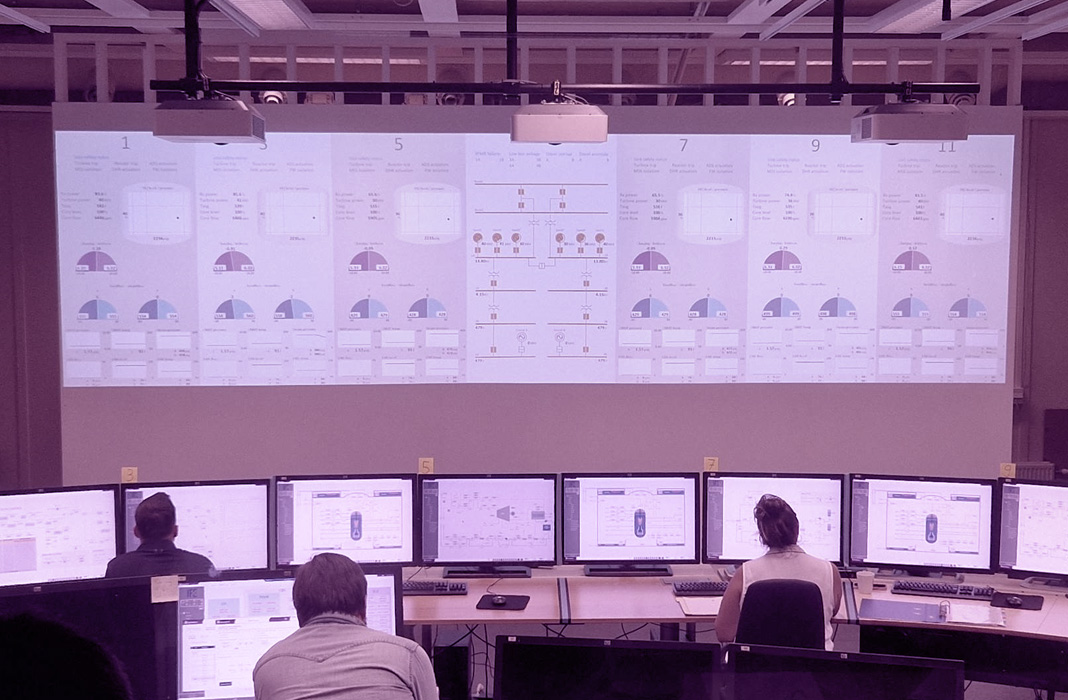Earlier this year we announced that Tecnatom would develop a multi-unit SMR simulator for
the Institute for Energy Technology, IFE, to be used for control room operation and monitoring
research. Now that the simulator is in operation,
Operational challenges of SMRs
Small Modular Reactors (SMRs) are a type of nuclear fission reactor, smaller in size and power
than conventional reactors (IAEA defines SMRs as below 300MWe), inherently safe and
relaying on passive safety systems. There are currently on the order of 70 commercial designs
for SMRs, ranging from scaled-down versions of existing nuclear reactor designs to completely
new Generation IV designs.
There are several factors that will determine the operation of these reactors such as:
- the multi-unit operation and modularity of their design
- extensive process automation
- their passive safety systems
- the possibility of remote operation
Therefore, the concept of operation in SMRs will have to be reconsidered with respect to the
assumptions made in conventional designs, proposing new approaches that will require an in-
depth evaluation.
The value contribution of a simulator
Human Factors Engineering (HFE) is a discipline that facilitates the design process of human-
system interfaces with the objective of minimizing the risk of human error. At Tecnatom, we
have been contributing to and developing HFE plans for various SMR designs, since HFE will be
one of the key processes in the licensing of this type of reactor, considering that it will allow
the evaluation of the new operating concepts mentioned above.
This is the context where the relevance of simulators as an engineering tool for HFE validation
experiments (process by which it is demonstrated that the design meets its objective) frames.
This is a clear example of SAE, Simulation Assisted Engineering, key to ease HFE validations,
providing them with a more global and integrated approach.
Tecnatom technology and experience in the project
In 2019, IFE started conducting SMR operation studies, based on the iPWR, Integral
Pressurized Water Reactor simulator that Tecnatom has developed for the IAEA. As scenarios
of greater complexity became necessary, IFE decided to count on us to develop a tool with
greater scope of operation, flexibility and multi-unit configuration.
ElThe simulator we have developed for IFE is a modular tool that, running on a single platform and guaranteeing real time, allows the simulation of 1 up to 12 generic SMR units, giving the tool versatility and flexibility for testing. The twelve units are identical to each other and share the electrical system, which is unique and common to the entire plant.
A key feature of this simulator, apart from this real-time configurability, is the potential for initial condition (IC) management through the Multi-unit IC Manager tool. Managing and maintaining the ICs in a single unit simulator is already laborious and costly; if this task is scaled up to 12 units, this workload multiplies. Therefore, we had the need to optimize the process by devising this IC manager. From a set of previously recorded ICs, which can be “pasted” by drag & drop to different units, the user is able to generate complex plant initial conditions in a simple and intuitive way.
Our TEAM TUTOR tool for the design of highly complex scenarios is another key improvement of the simulator, as it allows automating and supports the generation of these scenarios with multi-unit events, improving the efficiency of the scenario generation process and subsequent validations by being able to automatically replay them.
The simulator is completely developed with Tecnatom’s own simulation technology, TEAM_SUITE, from the thermal hydraulics, logic and electrical models to the graphical interface, including the simulation execution and control technology. The simulator has its own HMI, human-machine interface, designed by Tecnatom and based on our style guide and knowledge in HMI, but also connects to the interface designed by IFE precisely for its validation, making this connection quickly and safely.


Main benefits of using the simulator
The use of the simulator for the validation of Engineering, in this case of Human Factors, evidences this tool as great support for the SMRs licensing process because:
▪ It integrates the human-system interface designs and allows testing them dynamically and globally with the procedures and operators’ performance.
▪ It allows experiments to be run over a wide operational range and not just at full power, based on realistic and accurate simulations
▪ It improves product quality by reducing validation times.
The commissioning of the simulator at IFE’s facilities has allowed the completion of a first pilot course to evaluate the capabilities of the final product. From there, IFE has been able to continue with the empirical studies that had begun with the iPWR simulator, and that can now be carried out with a tool developed specifically for this purpose.







